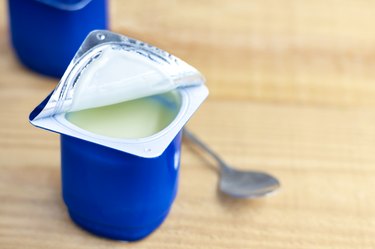
Dietary fats help our bodies absorb fat-soluble nutrients as well as help protect our organs, produce energy and keep the body warm, according to the American Heart Association. But it all boils down to choosing the right ones.
Replacing saturated fats with unsaturated fats including monounsaturated and polyunsaturated fats (MUFAs and PUFAs), as well as fiber-rich whole grains, can benefit heart health, according to a June 2017 review in Healthcare (Basel). Because of this, we shouldn't lump all fats in the same category, nor can we expect the same perks from all foods that contain fat.
Video of the Day
Video of the Day
"The answer to staying healthy and managing your weight isn't to cut out fat, it's to replace bad fats with good fats."
To shed some light on how the nutrient can benefit your diet, dietitians weigh in on common fat mistakes people make when they're building a meal plan.
1. You Think All Fats Are Created Equal
Fat is generally considered to be an undesirable macronutrient that people avoid when they're trying to lose weight. While it's true that all fats are more calorie-dense than other macros (fat contains 9 calories per gram while protein and carbs have 4 calories per gram each), you can't assume they are all one and the same.
"There are several types of fats — some of them are healthy and your body needs them to function properly," says Hayley Cimring, RD.
Dietary fat helps you absorb essential vitamins and minerals including vitamins A, D, E and K. It's also necessary for maintaining healthy hair, skin and nails and plays a role in blood clotting, muscle movement and managing inflammation, according to Harvard Health Publishing. And did you know fat is important for brain health, too? Omega-3 fatty acids, which are essential fats we get via our diets, help maintain healthy neural connections and cognitive function, according to an August 2018 article published in Current Neuropharmacology.
"The answer to staying healthy and managing your weight isn't to cut out fat, it's to replace bad fats with good fats," Cimring says.
- Saturated fats: These fats remain solid at room temperature and are found in animal products (such as beef fat and butter) and tropical oils (coconut oil and palm oil).
- Unsaturated fats: These come from plant sources including nuts, seeds and olives. These are your sources of MUFAs and PUFAs (essential fatty acids), which are linked to heart health.
- Trans fats: These come from partially hydrogenated oils (man-made fats) and are commonly found in highly processed foods including cakes, cookies, crackers, icing and margarine. Trans fats pose the greatest risk on your health and the FDA has determined that partially hydrogenated oils are no longer generally recognized as safe. Some animal products also contain naturally occurring trans fats, but these types aren't thought to be as detrimental as man-made trans fats.
Read more: 6 Foods that May Still Contain Trans Fats
Fix It
Include fat in your diet, but keep the focus on quality. Include heart-healthy fats such as nuts, fatty fish and olive oil in your diet. Saturated fats such as butter, lard, cheese tend to increase inflammation, while MUFAs and PUFAs help to mediate inflammatory responses. Be sure to include a small portion of healthy fat at each meal such as avocado on toast with breakfast, a loose handful of nuts for a snack or brush your chicken with olive oil before baking.
2. You Heavily Rely on Low-Fat and Fat-Free Foods

Because fat provides more calories per gram than other macronutrients, lower-fat diets are often the first line of intervention in weight loss.
But low-fat does not necessarily equate to healthier. "Low-fat and fat-free foods are usually promoted as healthy-eating options, and many people fall for this marketing gimmick. What they don't know is that these foods are often loaded with sugar and other additives that help improve their taste," Chiming says.
For example, a fat-free strawberry yogurt can contain as much sugar as a candy bar. And no one wants to be tricked into thinking that flavored yogurt is any healthier than candy.
Fix It
If you must buy something low-fat or fat-free, read the nutrition label to make sure the product isn’t loaded with sugar or additives and is actually lower in calories than its full-fat counterpart, Cimring says. Instead, choose the low-fat option over the non-fat to find a better balance between fats and sugars. “The golden rule is to steer clear from manufactured and industrially processed fats and take in more ‘real’ natural food fats that are good for your weight and health." Cimring recommends including avocados, olives, flaxseeds and fatty fish in your diet. But since all fat is calorie-dense, it’s still important to watch your portions.
3. You Eat Too Many Healthy Fats
Don't forgo portion control when it comes to healthy fats. "I hear a lot of people say things like, 'I add coconut oil and olive oil to everything,'" Shena Jaramillo, RD, says. A little goes a long way when it comes to fat intake. At a certain point, you aren't adding a lot of nutritional value to your day but you are still adding a lot of calories, which can lead to weight gain. Too much of a good thing isn't, well, good.
Nuts and avocadoes are perfect examples of healthy fat sources, but since they are packed with calories, you'll want to exercise portion control. A serving of nuts is just one ounce, according to the USDA. Because caloric values vary depending on the nut, one ounce (or a loose handful) ranges from 150 to 200 calories. You'll get 18 cashews in one ounce, 35 peanuts in an ounce and 24 almonds in an ounce, per the Cleveland Clinic.
And when we eat too many fats and focus on one food group, we miss out on the benefits of a balanced diet. Here's how your healthy plate should look like: Half of it should be filled with veggies and fruit (with the majority of the chunk being veggies), a quarter of the plate should be dedicated to healthy protein and the other quarter to whole grains, according to the Harvard T.H. Chan School of Public Health.
Include a bit of healthy fat like olive oil while limiting butter and avoiding trans fat. If you're eating too many fats — regardless of whether they're healthy — you may be missing out on heart-healthy fruits and vegetables as well as fiber-rich whole grains.
Fix It
Keep the large containers of nuts off of your desk, pre-measure your portions or buy single-size serving bags for better caloric control. Remember that just because it is a healthy fat, doesn’t mean it should take up a huge portion of your diet. Balance your macros to include protein; complex carbohydrates such as brown rice, quinoa, whole-grain bread (with around 4 grams per slice), beans and legumes; and focus on eating at least 2 cups of veggies per day.
4. You Put Too Much Emphasis on 'Good' and 'Bad'

Classifying food as "good" or "bad" doesn't serve us in any positive way. "If we attribute moral value to our food choices, then we give food too much credit," Rachel Fine, RD, says.
"Instead, a judgment-free, habit-based approach works to build mindful eating behaviors that enable you to tune into your intuitive feelings of hunger, fullness and satisfaction." Psychologically, an inclusive approach allows for enjoyment of all foods. Once we grant ourselves unconditional permission to eat our favorite foods, we relieve the weight of responsibility that these foods hold over us.
"We have to realize that no one food will ever make or break your health. Our food choices make up a larger part of our day, week or year," Fine says.
Fix It
"An inclusive approach is key to long-term success. Instead of rules, make choices," Fine says. "Add more nutrient-dense, plant-based whole foods like fresh produce, nuts, seeds and legumes to your meals. Use each meal or snack as an opportunity to honor your personal preferences while feeling confident that your choice will play a role in your personal health, whether that is your physical health or your mental health, or both."
- Lipids in Health and Disease: “Dietary total Fat, Fatty Acids intake, and Risk of Cardiovascular Disease: A Dose-response Meta-analysis of Cohort Studies”
- Healthcare (Basel): “Saturated Fatty Acids and Cardiovascular Disease: Replacements for Saturated Fat to Reduce Cardiovascular Risk”
- Harvard Health Publishing: "The Truth about Fats: The Good, the Bad, and the In-between"
- Current Neuropharmacology: “Impact of Dietary Fats on Brain Functions”
- Harvard T.H. Chan School of Public Health: “Healthy Eating Plate vs. USDA’s MyPlate”
- FDA: "Final Determination Regarding Partially Hydrogenated Oils (Removing Trans Fat)"
- USDA: "Go Nuts!"
- American Heart Association: "Dietary Fats"